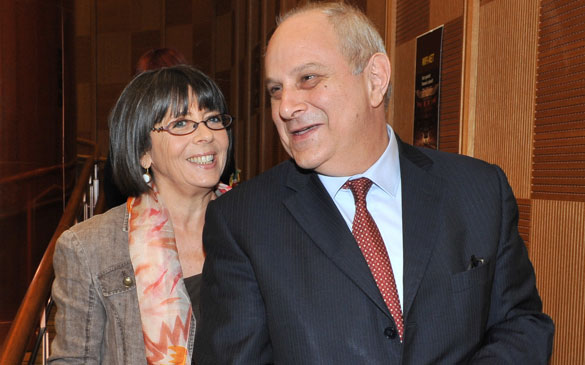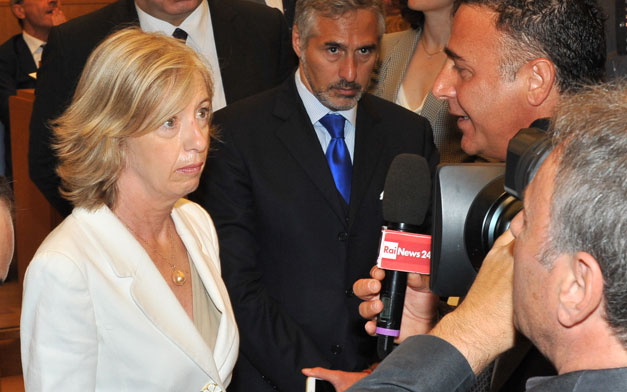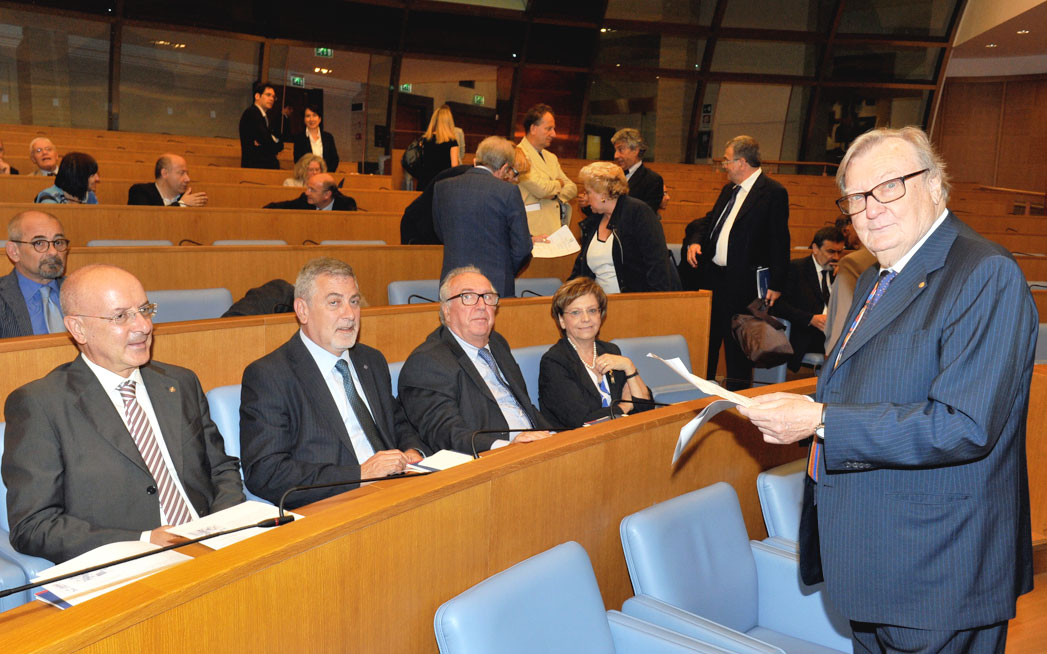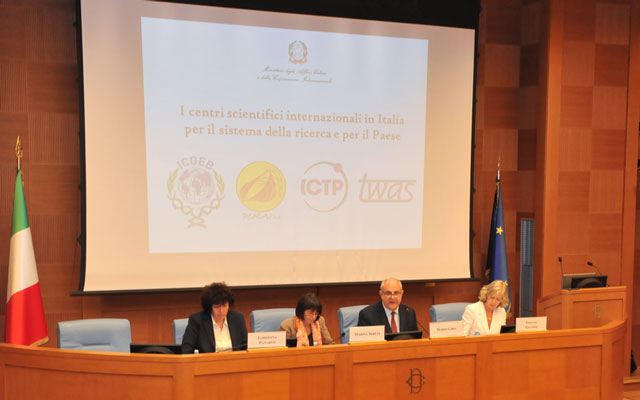Italy has developed strong collaborations that make it a global leader in sustainable development and in initiatives to build science and engineering in the developing world. Four institutions – including The World Academy of Sciences (TWAS) – have made that accomplishment possible by training young scientists, supporting scientific excellence and building networks that encourage cooperation between scientifically lagging countries and developed nations.
Leaders of the four science centres reported to top officials from the Italian Parliament and the Ministry of Foreign Affairs during a special event on 10 June. The event, hosted by the Chamber of Deputies, was titled "The international science centres in Italy for the system of research and for the country". In addition to TWAS, the event featured two other Trieste-based centres, the Abdus Salam International Centre for Theoretical Physics (ICTP) and the International Centre of Genetic Engineering and Biotechnology (ICGEB), along with the International Center for Relativistic Astrophysics Network (ICRANet), which is based in Pescara.
"These four centres represent a major point of strength in the Italian plan that envisions the internationalization of 'Made in Italy'," said Mario Giro, undersecretary for foreign affairs and international cooperation. He stressed that their presence and scientific activity in Italy have important, positive impacts on Italy's international image. In fact, they help shape the global agenda of Italian research and help Italy to establish and maintain important strategic alliances.
Romain Murenzi, the executive director of TWAS, surveyed the Academy's successes in building a respected global academy that supports science in the developing world. But the progress would not have been possible without Italy's "steadfast" support, he said.
"Through every step, the government of Italy was a partner in our mission to build science in developing world", Murenzi noted. "It is no exaggeration to say that, without Italy, none of our accomplishments would be possible."
Among the participants, representatives for the policy institutions were: Marina Sereni, vice president of the Chamber of Deputies; Stefania Giannini, minister of education, university and research; and Loredana Panariti, assessor of the Region Friuli Venezia Giulia in charge of employment, training, education, equal opportunities, youth policies, research and universities.
Presentations from the international research institutions also were given by Fernando Quevedo, director of ICTP; Mauro Giacca, director general of ICGEB; and Remo Ruffini, director of ICRANet. Among the attendees at the Chamber was also Nobel Prize winner Carlo Rubbia, a 1992 TWAS Fellow. 
Giro noted that Italy's annual investment of approximately 30 million euros in the science institutions generates high return, not only in terms of production or employment, but also in terms of collaborations with other organizations, other countries and such private foundations as the Bill and Melinda Gates Foundation. "The Italian administration will continue to support these systems as a global resource", Giro told the audience.
Sereni noted that it is a source of national pride for such prestigious science institutions to be based in Italy. She also stressed the importance of organizing the presentation at the Chamber: "We are willing to learn in what ways the Parliament can support and help your activity", she said.
The share of gross domestic product that Italy devotes to research is still below the average, Sereni said, but the quality of scientific information produced is comparable to that of the major European countries.The quality of international collaborations marks Italy's high ranking in the international research scene.
Giannini noted the importance of choosing the Chamber of Deputies as the venue to discuss Italian frontier research. The four centres have in common scientific excellence, international scope and focus on cooperation, she said. And, she added, these qualities must become an integral part of the national agenda – with a commitment from the Parliament. "Speaking of science here carries a very strong political message," Giannini said. "We shall soon have to insert our views in a European context, and our national research plan will have to fit in the landscape of European research."
A further critical point touched upon by the minister was the importance of human capital: research is being done by men and women, by young people, and it is essential to have a clear idea of where Italy stands now and in what direction it intends to go. "Global cooperation will lead us to internationalization," Giannini said, "which is an integral part of scientific excellence."
Today, there are some 80 million young people in Europe between the ages 15 and 24. According to recent estimates, that number will drop to 73 million by 2050. On the other hand, the 226 million young Africans that today live on the African continent will be 400 million in 2050. "What we need is a European 'knowledge valley' that pursues common objectives", said Giannini. If Italy's policies are successful in taking a first step in this direction, Italy will succeed in developing a career path and in arranging knowledge transfer towards the society, so as to complete the work done so far by individual centres.
Panariti, the regional assessor for employment in Friuli Venezia Giulia, addressed the role of Trieste as a driving force for international networks of scientific excellence. She also highlighted the region's impressive infrastructure for research activity. Among the strategic objectives that the region has to pursue, she said, it is essential to boost this scientific network of excellence and enhance coordination within the network.
Then the institutions' directors took the floor, to summarize their achievements. Fernando Quevedo, director of ICTP, said that his centre since its founding in 1964 has seen more than 100,000 foreign scholars transit through Trieste, "many of whom today consider themselves invisible ambassadors of Italy in their home countries."
Mauro Giacca, the director of ICGEB, presented frontier research of the centre for genetic engineering, including investigations into myocardial infarction and the identification of the site within the cell where the HIV virus hides. He also presented the international activity carried out by ICGEB in its three locations – Trieste, New Delhi and Cape Town.
Remo Ruffini, the director of ICRANet, presented some of the most recent discoveries in astrophysics. He pointed out that thanks to optical-fibre communication, the young researchers working in the various locations of ICRANet can obtain data coming in from the major Earth and space observatories, which exemplifies the international character of the network.
Murenzi highlighted a TWAS network that has grown over the past three decades to encompass the world. TWAS has nearly 1,150 Fellows from 90 countries, and has three partners that operate under the Academy's umbrella:
- The Organization for Women in Science for the Developing World (OWSD), a pioneering forum that unites women scientists from the developing and developed worlds, with more than 4,000 members;
- IAP, the global network of science academies, which serves as the voice to more than 100 national and regional academies; and
- The InterAcademy Medical Panel (IAMP), a network of the world's medical academies that provides strong advice on health issues of global importance.
However, Murenzi said, "our work is far from complete. While we can point to many success stories, 81 nations remain classified as lagging in science and technology. Of the world's 48 Least Developed Countries, 34 are in Africa. And indeed, Africa has only begun to tap its potential in science and engineering."
"Africa is a young continent with so much promise, but it will take commitment to fully develop this potential. I promise you that TWAS, OWSD, IAP and IAMP are focused on building stronger African nations through science and science education.
"Italy has provided life-giving contributions to our work, in good times and bad," Murenzi added. "This is why I say that, among scientists in the developing world, the beautiful Italian city of Trieste is seen as a leader, and as a beacon of hope. When you talk about TWAS – when you talk about ICTP, ICGEB and ICRANet – our scientists inevitably think of Italy with admiration and with the deepest gratitude."
Cristina Serra

